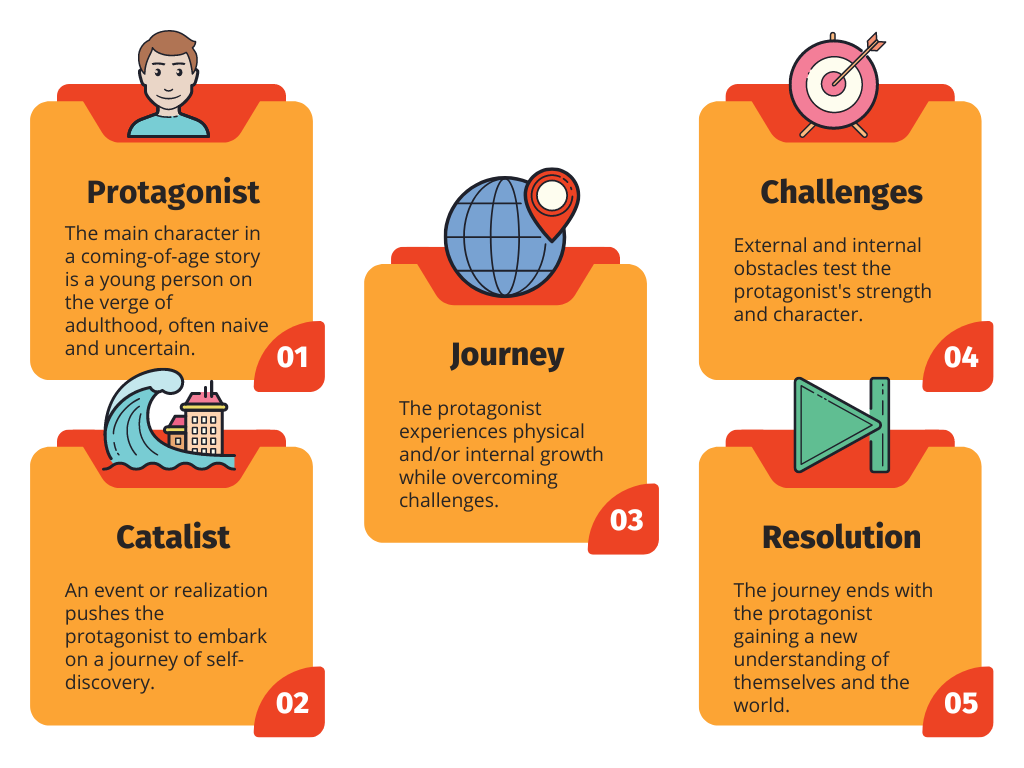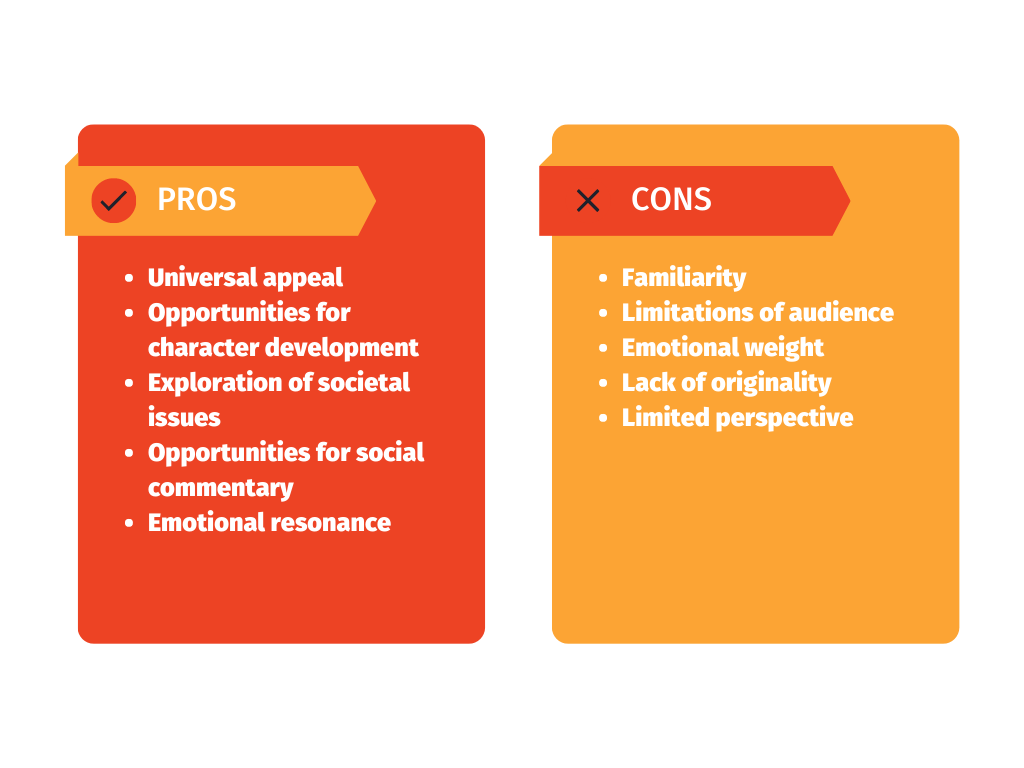Picture a slingshot. Its band pulled taut, the pebble straining back, poised for flight. That’s your protagonist. But coming-of-age isn’t about the moment the pebble zips free; it's about the cosmic forces yanking that band back.
We all recall our first wobbly steps into the madness of adulthood, right? The world, like some twisted chiropractor, jerking you around until every vertebra of your innocence got crunched. Then, just like that, they slap you on the ass and boom! "Congratulations, you're an adult." Imagine packing all that chaos into a neat parcel of words, a Pandora's box of adolescence ready to pop open on cue.
Coming-of-age is about skinning your knees on the gravel of life, then standing up to show off your scars. It’s your teenage protagonist flailing against the straightjacket of childhood, then stumbling, dazed and blinking, into the unforgiving daylight of adulthood.
This isn't the stroll through the rose garden of bildungsroman, where everything’s as neat and organized as a Swiss watch. Hell no. Coming-of-age is the thunderstorm that turns that rose garden into a mud pit. It's the horrifying revelation that roses have thorns, and those thorns draw blood.
Now, you think this is just about some kid sprouting armpit hair, or their first fumbling attempt at love? You're punching below your weight, my friend. It's about war. The raging battle between who they are and who they're expected to be. It's about the white-knuckled grip on the security blanket of childhood, then the primal scream when it's ripped away.
You ready to take your reader on that wild ride? Dive into the vertigo of metamorphosis, strip down the veneer of civilization, and expose the raw, pulsing heart of human experience? Good. Keep your hands inside the vehicle at all times, it’s going to be a bumpy ride.
The Anatomy of a Coming-of-Age Story

At the raw core of a coming-of-age story, there's this young hotshot, straddling the precarious cliff edge between wide-eyed childhood and the gnarled forest of adulthood. This ain't no afternoon stroll; it's an odyssey over broken glass, through a world that wants to slap them with a tough love education. A brutal baptism by fire, pushing them to question their neatly packaged beliefs, stare down their frailties, and emerge, scarred but stronger.
Some common elements of a coming-of-age story include:
- The protagonist: The main character of a coming-of-age story is typically some green kid balanced on the tightrope of adulthood. They're green as spring grass, powered by starry-eyed ideals, and wrestling with the existential jigsaw puzzle of their place in this chaotic circus we call life.
- The catalyst: That's the spark that lights the fuse, the earthquake that splits open their world. Could be a soul-jarring trauma, a life-altering twist, or the sudden slap of self-awareness that they need to carve out their own grooves in the vinyl record of life..
- The journey: Then, bam! They're off on this wild roller coaster of self-discovery, a journey that might physically move them from A to B, or metaphorically haul them through the twisted caverns of their own psyche.
- The challenges: Our greenhorn is tossed into a gauntlet of challenges designed to test their mettle, squeeze out their true character like toothpaste from a tube. Monsters may lurk around corners, physical hurdles might rear their ugly heads, or they might be wrestling the more insidious demons lurking in their own minds.
- The resolution: The wild ride careens to a stop. Our protagonist, battered but not beaten, steps off the ride with new eyes. Maybe they find the closure they've been hunting, or perhaps they just stride towards the horizon, a renewed sense of purpose burning in their gut.
Examples from Fiction
Some of the most beloved novels of all time are coming-of-age stories. Here are just a few examples:
- To Kill a Mockingbird by Harper Lee: Picture Scout Finch, a scrappy kid slogging through the muck and mire of Depression-era Alabama, staring racism and justice right in the gargoyle face. All the while, the ghost of innocence gets strangled right before her eyes.
- The Catcher in the Rye by J.D. Salinger: You got Holden Caulfield, a ticking time bomb of teenage angst, taking a baseball bat to the sugar-coated lie of adulthood, smearing the bloody hypocrisy of conformity all over its neat little white picket fences.
- The Perks of Being a Wallflower by Stephen Chbosky: Here's our guy Charlie, a high school greenhorn trying to keep his head above the churning seas of adolescence. Tossed around by the tempest of first love, the grim specter of mental illness, and the mind-bending quest for selfhood, he learns to swim or drown.
Pros and Cons of Coming-of-Age Stories

If you're considering writing a coming-of-age story, it's important to weigh the pros and cons of this genre.
Pros
- Universal appeal: Coming-of-age tales have this eternal heartbeat that syncs with any reader, regardless of their passport or calendar age. It's a genre older than dirt and just as enduring.
- Opportunities for character development: Got a yen for crafting characters as complex and flawed as a Picasso painting? This is your canvas. You can weave characters that twist and morph like a river finding its path to the sea.
- Exploration of societal issues: Through the peephole of your protagonist, you can shine a floodlight on society's warts - discrimination, prejudice, identity crises. All the tasty taboos, served up raw and ready for your readers to gnaw on.
- Opportunities for social commentary: Unmasking societal ills ain't just about the reveal. It's about that delicious moment of biting commentary on race, gender, class - the hot buttons of our times.
- Emotional resonance: Tap into the throbbing vein of first love, innocence lost, identity quests. With these emotional TNT sticks, you can blow your reader's world wide open.
Cons
- Familiarity: The coming-of-age route's well-trod, like the same damn tourist trail everybody takes. Can you hack a new trail that'll make readers sit up and salute?
- Limitations of audience: Your tale may end up pigeonholed for a specific age group, like some obscure niche Netflix category. High school angst, college turmoil - they resonate best with readers walking the same tightrope.
- Emotional weight: Unpacking sensitive subjects can tax your soul and your reader's. Can you navigate this minefield with grace, authenticity, and guts?
- Lack of originality: Some readers are done with the cookie-cutter mold of coming-of-age stories. Can you make your tale sing a fresh tune?
- Limited perspective: Your protagonist's lens can warp the world view, especially if it recycles harmful stereotypes or airbrushes the rich tapestry of diverse experiences. Ready to tackle this challenge?
How to Write a Coming-of-Age Story
If you're ready to take on the challenge of writing a coming-of-age story, here are some tips and best practices to keep in mind:
- Start with character: Your protagonist is your story's lifeblood, pumping through every artery of your narrative. Take a chisel to their rough-hewn mass - their backstory, relationships, quirks. See how their world - the family circus, the social chessboard, the environmental playground - shapes them, breaks them, makes them.
- Choose your setting carefully: Your setting's the canvas to your protagonist's Pollock splatter. Time, place, culture - every dimension plays a part in shaping the protagonist's journey. Think about how a backwoods town versus a bustling metropolis might mold your character's metamorphosis.
- Explore universal themes: Coming-of-age tales are like Russian dolls, each unique story nested inside shared human experiences - identity, belonging, existential roadmaps. Carve out these universal themes with your character's own chisel. Maybe they're wrestling the anaconda of racial identity or grappling with the many-headed hydra of sexual orientation.
- Avoid clichés: Tired tropes are the quicksand of coming-of-age tales. Can you tap dance around them, or better yet, flip them on their heads? Maybe your protagonist doesn't find earth-shattering love; maybe they forge an ironclad bond of friendship with an unlikely ally.
- Stay true to your character's voice: Nail down your protagonist's voice, then tattoo it onto every page. Authentic, consistent, real. Whether your character's a teenager experimenting with linguistic rebellion or a grizzled vet spitting hard-earned wisdom, their voice is your compass.
- Consider subverting expectations: Sure, coming-of-age narratives have a well-worn groove, but can you toss a wrench in the gears? Maybe your protagonist doesn't snatch victory from the jaws of defeat, or maybe their choices skew off the expected path.
Writing a coming-of-age tale is like wrestling a tiger, but hell, isn't that why you picked up the pen in the first place? Focus on your character, your setting, your themes, dodge the clichés, and let your character's voice sing. You just might compose a symphony that echoes in readers' hearts for generations.
Best Practices
Here are some best practices to keep in mind when writing a coming-of-age story:
- Read widely: Devour the classics and the modern hits of coming-of-age lore. They're your trail of breadcrumbs, lighting the path through the dense thicket of style, structure, and theme.
- Do your research:If you're plunging into a different time or culture, roll up your sleeves and dig into the grit and grime. Get to know the fashion trends that were hotter than a two-dollar pistol, the music that set feet tapping, the world events that shook things up. Nail down the customs, values, and rituals. Authenticity ain't an optional extra.
- Develop your characters: Spend some quality time with your characters. Mold them, shape them, know their quirks and neuroses like they're your own. It's their trials by fire, their scars and victories, that'll set your readers' hearts pounding.
- Explore themes: Give your tale a backbone of iron with themes that hit home. Identity, belonging, that first taste of freedom, the treasure hunt for self - use your characters and their story to shine a light on these universal rites of passage.
- Get feedback: Share your precious creation with beta readers, throw it into the arena of a writers' group. It's their praise, their gut punches, their keen-eyed critiques that'll hone your tale to a razor's edge.
- Revise, revise, revise: Crafting a story worth its salt means grinding the rough edges, polishing the gems. It's about kneading your tale until it's as smooth as butter - pacing, structure, dialogue, description. Make sure every piece fits, every cog turns, every note in your symphony sings true to your characters and their journey.
Crafting a coming-of-age saga, whether it's rooted in the grit of reality or fluttering on the wings of fantasy, is a baptism by fire for writers from all walks of life. Start by etching your character's heart, tap into the universal rhythms of human experience, and let your protagonist's voice ring true. With this road map and a dash of audacious creativity, you're geared up to chisel out a tale of youth that'll echo through the ages. This isn't just storytelling, it's archaeology, digging into the marrow of what it means to step into adulthood. Buckle up and embrace the ride.



Comments ()